The constellations best seen in January are Caelum, Dorado, Lepus, Mensa, Orion, Pictor, Reticulum and Taurus. Two of these constellations – Orion and Taurus – are quite prominent in the evening sky, while others are simply best observed at this time of year. Orion, Taurus and Lepus are northern constellations, located in the first quadrant of the northern hemisphere, while others lie in the first quadrant south of the celestial equator.
January is the best time of year to observe a number of famous deep sky objects located in these constellations. The most popular telescope targets include the Orion Nebula (M43), the Crab Nebula (M1), the Pleiades (M45) and Hyades clusters, and the Large Magellanic Cloud.
Taurus and Orion are the largest and best known January constellations. Known since ancient times, these constellations dominate the northern winter sky and host a number of well-known stars, asterisms and deep sky objects.
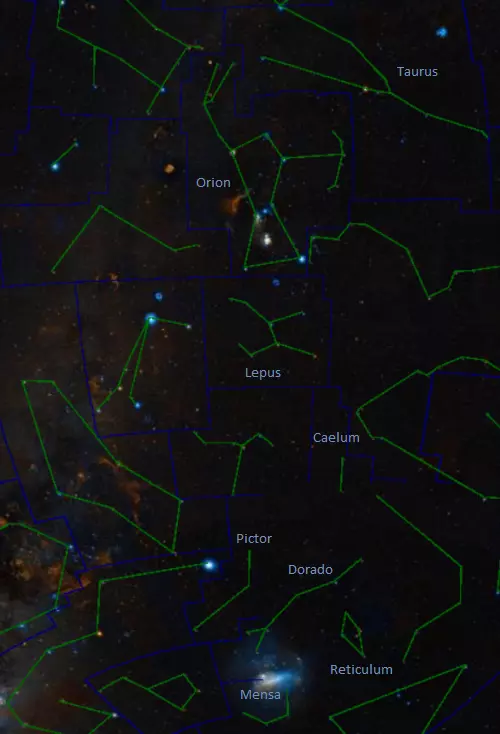
January constellations, image: Wikisky
Taurus, the 17th largest of all star constellations, represents the celestial Bull. It occupies an area of 797 square degrees. Like other zodiac constellations, it was first catalogued by the Greek astronomer Ptolemy in the 2nd century, but has been known since the Bronze Age.
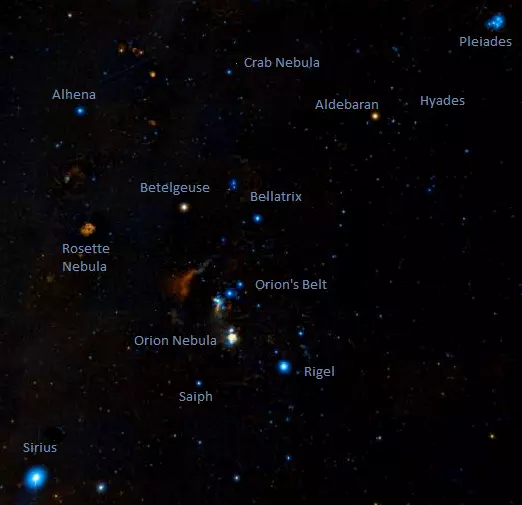
Constellations Orion and Taurus, image: Wikisky
The constellation is very easy to find because it is home to one of the nearest star clusters to Earth and one most easily seen without binoculars. The Pleiades open cluster, also known as the Seven Sisters, catalogued by Charles Messier as Messier 45, consists of a number of hot, young, luminous stars surrounded by a faint reflection nebula. The cluster lies approximately 444 light years from Earth and has an apparent magnitude of 1.6. With an apparent size of 110 arc minutes, it is very conspicuous in the winter sky, with about a dozen stars visible to the unaided eye in good conditions.
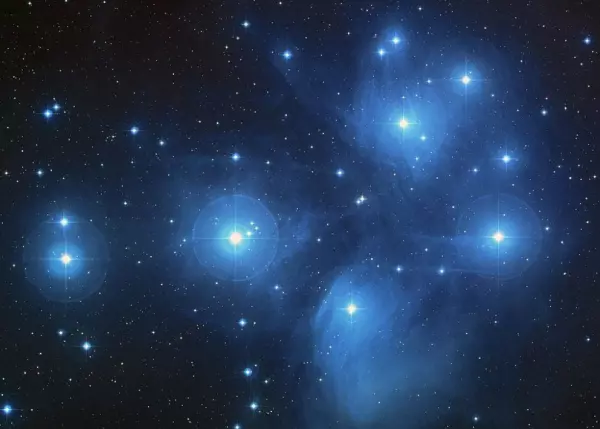
The Pleiades is an open cluster consisting of approximately 3,000 stars at a distance of 400 light-years (120 parsecs) from Earth in the constellation Taurus. (It also known as “The Seven Sisters”, or the astronomical designations NGC 1432/35 and M45.) Image: NASA, ESA, AURA, Caltech, Palomar Observatory
Taurus contains another famous Messier object: the Crab Nebula. Catalogued as Messier 1, the nebula is an expanding remnant of a supernova event observed in 1054 AD. It has a visual magnitude of 8.4, which makes it visible in binoculars in exceptionally good conditions. The nebula contains the Crab Pulsar, the youngest pulsar observed.
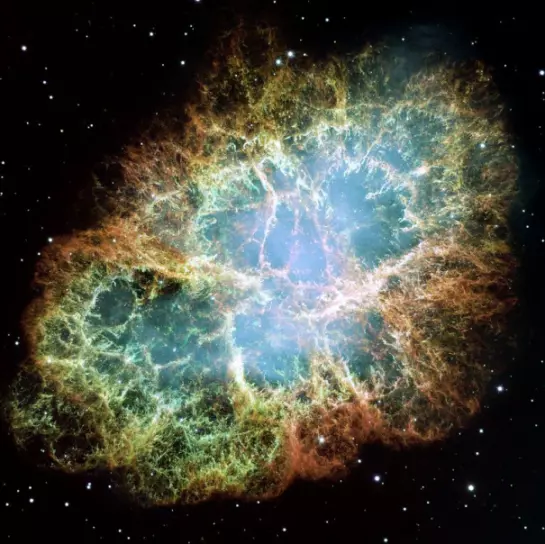
This is a mosaic image, one of the largest ever taken by NASA’s Hubble Space Telescope of the Crab Nebula, a six-light-year-wide expanding remnant of a star’s supernova event. Japanese and Chinese astronomers recorded this event nearly 1,000 years ago in 1054, as did, almost certainly, Native Americans. The orange filaments are the tattered remains of the star and consist mostly of hydrogen. The rapidly spinning neutron star embedded in the center of the nebula is the dynamo powering the nebula’s eerie interior bluish glow. The blue light comes from electrons whirling at nearly the speed of light around magnetic field lines from the neutron star. The neutron star, like a lighthouse, ejects twin beams of radiation that appear to pulse 30 times a second due to the neutron star’s rotation. A neutron star is the crushed ultra-dense core of the progenitor star. The Crab Nebula derived its name from its appearance in a drawing made by Irish astronomer Lord Rosse in 1844, using a 36-inch telescope. When viewed by Hubble, as well as by large ground-based telescopes such as the European Southern Observatory’s Very Large Telescope, the Crab Nebula takes on a more detailed appearance that yields clues into the spectacular end of a star, 6,500 light-years away. Image: NASA, ESA, J. Hester and A. Loll (Arizona State University)
Taurus is also home to the Hyades cluster, a group of relatively bright stars forming a V shape that represents the head of the bull. Aldebaran, the brightest star in Taurus and the 14th brightest star in the sky, lies in the same line of sight as the Hyades, but is considerably closer to us at a distance of 65 light years. The cluster on the other hand lies about 153 light years from Earth. Aldebaran merely makes it easy to find it.
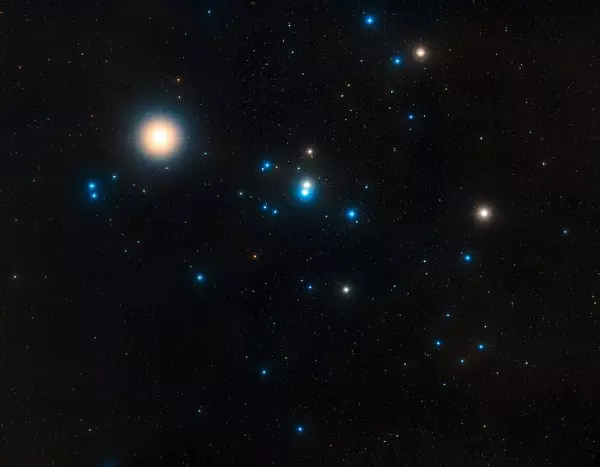
This image shows the Hyades star cluster, the nearest cluster to us. The Hyades cluster is very well studied due to its location, but previous searches for planets have produced only one. A new study led by Jay Farihi of the University of Cambridge, UK, has now found the atmospheres of two burnt-out stars in this cluster — known as white dwarfs — to be “polluted” by rocky debris circling the star. Seeing evidence of asteroids points to the possibility of Earth-sized planets in the same system, as asteroids are the building blocks of major planets. Planet-forming processes are inefficient, and spawn many times more small bodies than large bodies — but once rocky embryos the size of asteroids are built, planets are sure to follow. Image: NASA, ESA, and STScI
Aldebaran can be found by following the line formed by the three stars of Orion’s Belt in the direction of Taurus.
Orion is one of the most recognizable constellations in the sky. Its distinct hourglass shape is formed by seven highly luminous stars, making the celestial hunter quite prominent in winter evenings.
The supergiants Betelgeuse, Rigel and Saiph and giant Bellatrix form the outline of the hourglass, while the supergiants Alnitak and Alnilam and giant Mintaka form Orion’s Belt, one of the best known asterisms in the sky. Rigel and Betelgeuse are among the ten brightest stars, while even the faintest of these seven stars – Mintaka – shines at magnitude 2.23.
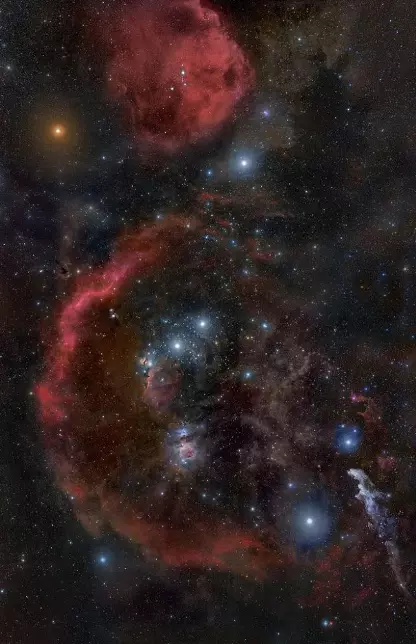
Photo taken by Rogelio Bernal Andreo in October 2010 of the Orion constellation showing the surrounding nebulas of the Orion Molecular Cloud complex. Also captured is the red supergiant Betelgeuse (top left) and the famous belt of Orion composed of the OB stars Alnitak, Alnilam and Mintaka. To the bottom right can be found the star Rigel. The red crescent shape is Barnard’s Loop. The photograph appeared as the Astronomy Picture of the Day on October 23, 2010. Image: Rogelio Bernal Andreo
Orion is home to the Orion Molecular Cloud Complex, a vast star forming region that contains a number of well-known nebulae. These include the Orion Nebula (M42), De Mairan’s Nebula (M43), Messier 78, the Flame Nebula (NGC 2024), IC 434 with the dark Horsehead Nebula (NGC 2023) and Barnard’s Loop.
Occupying an area of 594 square degrees, Orion is the 26th largest of all constellations. It has been known since ancient times and associated with countless myths by cultures around the world. In star maps, Orion is usually depicted either as pursuing the Pleiades sisters, facing the charge of the celestial Bull, or chasing the hare represented by the constellation Lepus.
Located just south of the celestial equator, Lepus is not as prominent as Orion and Taurus, but contains several notable deep sky objects which make it a popular target among stargazers. These include the globular cluster Messier 79, the Spirograph Nebula (IC 418), a planetary nebula named for its striking appearance, and the irregular galaxy NGC 1821.
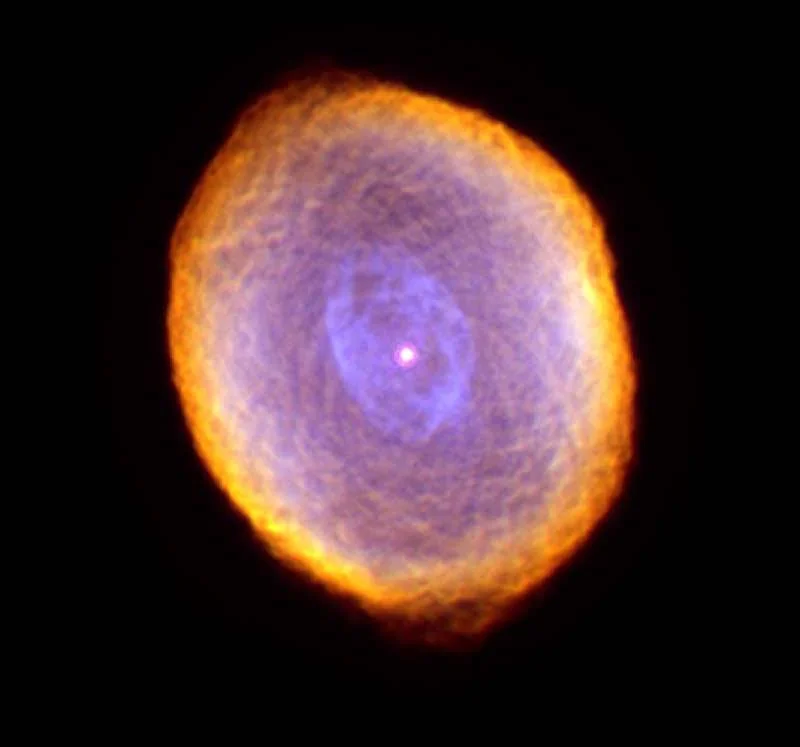
The Spirograph Nebula (IC 418), photographed by the Hubble Space Telescope’s Wide Field Planetary Camera 2. Image: NASA and The Hubble Heritage Team (STScI/AURA)
Situated south of Lepus, Caelum is one of the least conspicuous constellations in the sky. Occupying an area of only 124 square degrees, it is the eight smallest of all 88 constellations. It does not have any bright stars or objects of particular interest to backyard observers.
Pictor, Dorado and Reticulum are invisible to observers north of tropical latitudes, while Mensa can only be seen south of 4°N, which is to say, it can only be seen by observers south of the equator and those in northern equatorial latitudes.
Pictor is located between Canopus, the second brightest star in the sky, and the Large Magellanic Cloud, a bright, large dwarf irregular galaxy which can be seen without binoculars, situated on the border of Dorado and Mensa. Pictor itself is quite faint, without any stars brighter than magnitude 3.00. Its brightest stars are visible near Canopus. Notable deep sky objects in the constellation are few. They include the double-lobed radio galaxy Pictor A and the irregular dwarf galaxy NGC 1705.
Reticulum is the 82nd constellation in size with an area of only 113 square degrees. It is quite faint, with only two stars brighter than magnitude 5. Interesting deep sky objects in the constellation include the barred spiral galaxies NGC 1559 and NGC 1313, the latter of which is also known as the Topsy Turvy Galaxy.
Dorado and Mensa are also among the smallest constellations, 72nd and 75th in size respectively. Neither of them have any stars brighter than magnitude 3.00, which also makes them pretty faint. However, as they host the Large Magellanic Cloud (LMC), these constellations are very rich in interesting deep sky objects.
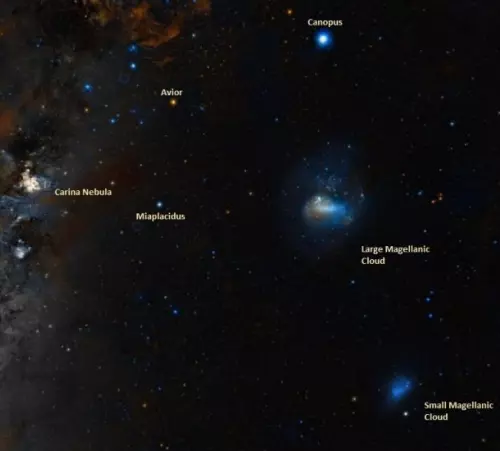
Magellanic Clouds, image: Wikisky
The Milky Way’s famous satellite galaxy is the fourth largest member of the Local Group, after Andromeda (M31), the Milky Way and the Triangulum Galaxy (M33). It occupies an area 20 times the size of the full Moon. With a visual magnitude of 0.9, the LMC is easily visible without binoculars.
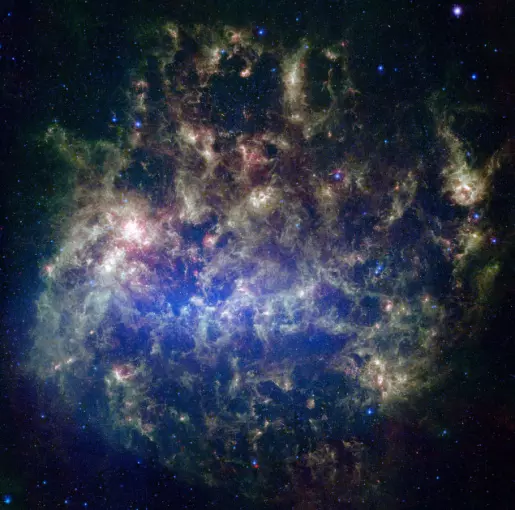
This image from NASA’s Spitzer Space Telescope shows the Large Magellanic Cloud, a satellite galaxy to our own Milky Way galaxy. The infrared image, a mosaic of 300,000 individual tiles, offers astronomers a unique chance to study the lifecycle of stars and dust in a single galaxy. Nearly one million objects are revealed for the first time in this Spitzer view, which represents about a 1,000-fold improvement in sensitivity over previous space-based missions. Most of the new objects are dusty stars of various ages populating the Large Magellanic Cloud; the rest are thought to be background galaxies. Image: NASA/JPL-Caltech/M. Meixner (STScI) & the SAGE Legacy Team
The galaxy contains about 60 known globular clusters, 700 open clusters, 400 planetary nebulae and a number of notable stars and other deep sky objects. Most of these are located in Dorado, which hosts most of the LMC. The best known deep sky objects in the galaxy are the Tarantula Nebula, the most active star forming region in the Local Group, the Ghost Head Nebula (NGC 2080), the Seagull Nebula (NGC 2032), N44, an emission nebula with superbubble structure, the supernova remnant SN 1987A and the bright globular cluster NGC 1783.
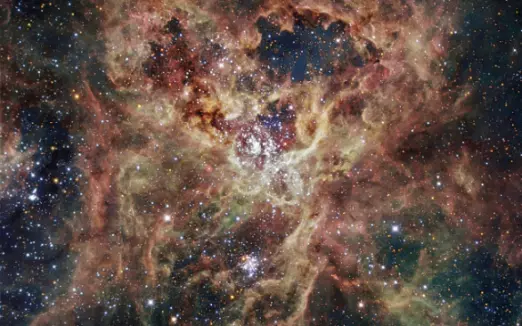
Located inside the Large Magellanic Cloud (LMC) – one of our closest galaxies – in what some describe as a frightening sight, the Tarantula nebula is worth looking at in detail. Also known as 30 Doradus or NGC 2070, the nebula owes its name to the arrangement of its bright patches that somewhat resemble the legs of a tarantula. Taking the name of one of the biggest spiders on Earth is very fitting in view of the gigantic proportions of this celestial nebula — it measures nearly 1,000 light years across ! Its proximity, the favourable inclination of the LMC, and the absence of intervening dust make this nebula one of the best laboratories to better understand the formation of massive stars. This spectacular nebula is energised by an exceptionally high concentration of massive stars, often referred to as super star clusters. Image: ESO/IDA/Danish 1.5 m/R. Gendler, C. C. Thöne, C. Féron, and J.-E. Ovaldsen
Dorado is also home to the super star cluster NGC 1850, the bright emission nebula NGC 1763, and the Dorado Group of galaxies, one of the richest galaxy groups in the southern sky. The dominant members are the interacting pair NGC 1549 and NGC 1533 and the spiral galaxy NGC 1566, also known as the Spanish Dancer.
Interesting deep sky objects in Mensa include the globular cluster NGC 1987, the open cluster NGC 1848 and the distant quasar PKS 0637-752.
The table below shows the latitudes between which the January constellations are visible.
| Constellation | Northern latitude | Southern latitude |
| Caelum | 40° | 90° |
| Dorado | 20° | 90° |
| Lepus | 63° | 90° |
| Mensa | 4° | 90° |
| Orion | 85° | 75° |
| Pictor | 26° | 90° |
| Reticulum | 23° | 90° |
| Taurus | 90° | 65° |